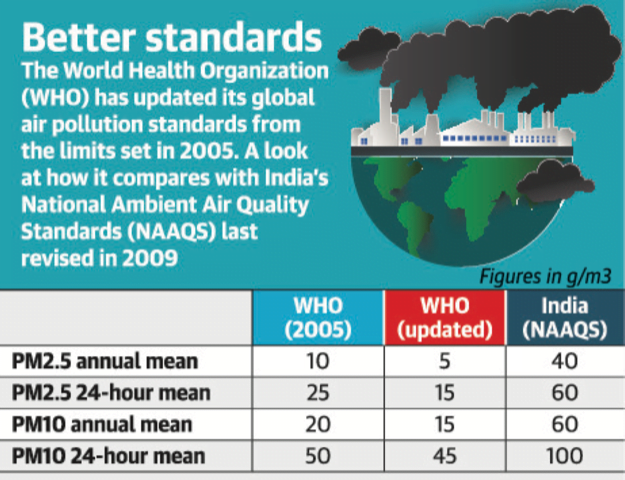Context
-
Recently, WHO tightens global air quality norms.
- The World Health Organization (WHO) in its first-ever update since 2005 has tightened global air pollution standards in a recognition of the emerging science in the last decade that the impact of air pollution on health is much more serious than earlier envisaged.
Key Details
- The guidelines propose new air quality standards to protect people’s health by lowering levels of major air contaminants, some of which are also linked to climate change.

- Countries will preserve public health as well as mitigate global climate change by attempting to achieve these guideline levels.
- The WHO’s decision paves the way for future policy adjustments in the government toward the development of newer, more stringent criteria.
- The WHO’s new guidelines recommend air quality standards for six contaminants for which the data on health impacts from exposure has progressed the most.
- Particulate matter (PM 2.5 and 10), ozone (O3), nitrogen dioxide (NO2), sulphur dioxide (SO2), and carbon monoxide (CO) are the six classic pollutants.
Human health effects of Air Pollution
- Air pollution, along with climate change, is one of the most serious environmental dangers to human health, according to the WHO.
- Air pollution is projected to cause 7 million premature deaths per year, as well as the loss of millions of healthy years of life.
- Reduced lung growth and function, respiratory infections, and asthma flare-ups are all possibilities in youngsters.
- Heart disease and stroke are the most prevalent causes of premature death in adults due to outdoor air pollution, although evidence of other consequences such as diabetes and neurodegenerative disorders is now emerging.
- This puts the illness burden associated with air pollution in line with the other significant global health concerns like poor diet and cigarette use.
- Air pollution exposure disparities are widening over the world, particularly in low- and middle-income nations, as a result of large-scale urbanisation and economic development that has mostly relied on the combustion of fossil fuels.
Air quality standards in India
India’s Pollution Situation?
- India remains one of the world’s most polluted countries, with pollution levels three times higher than recommended.
- According to a Greenpeace analysis, in 2020, the average PM2.5 concentration in New Delhi will be roughly 17 times higher than the permissible levels.
- Pollution levels were eight times higher in Mumbai, over nine times higher in Kolkata, and over five times higher in Chennai.
- According to specialists from the Global Burden of Disease study, more than 95 percent of India’s population already lived in places with pollution levels above WHO’s 2005 standards.
- Even when compared to WHO’s 2005 guidelines, India’s national air quality regulations are far more liberal.
- The acceptable PM2.5 concentration over a 24-hour period, for example, is 60 micrograms per cubic metre, compared to the WHO’s 2005 standards of 25 micrograms.
- Even these lower standards, however, are rarely reached.
Impact on India
- According to the new air quality rules, practically all of India would be classified filthy for the majority of the year.
- However, the WHO admits that more than 90% of the world’s population lives in places that do not meet its pollution criteria from 2005.
- The new WHO guidelines should encourage India to work harder to improve its air quality and safety.
- Furthermore, the new rules’ viability is debatable, particularly in difficult geo-climatic zones such as South Asia, which includes India.
- Experts note that this region has difficult meteorological and climatic conditions, as well as haze columns, heat island effects, and extremely high base pollution levels.
- The measure, however, has no immediate impact on India because the country’s National Ambient Air Quality Requirements (NAAQS) do not meet the WHO’s existing standards.
- The government has a specific National Clean Air Program that seeks to reduce particulate matter concentrations by 20 percent to 30 percent in 122 cities by 2024, using 2017 as the baseline year for comparison.
Environment Current Affairs UPSC 2021 : Click Here
